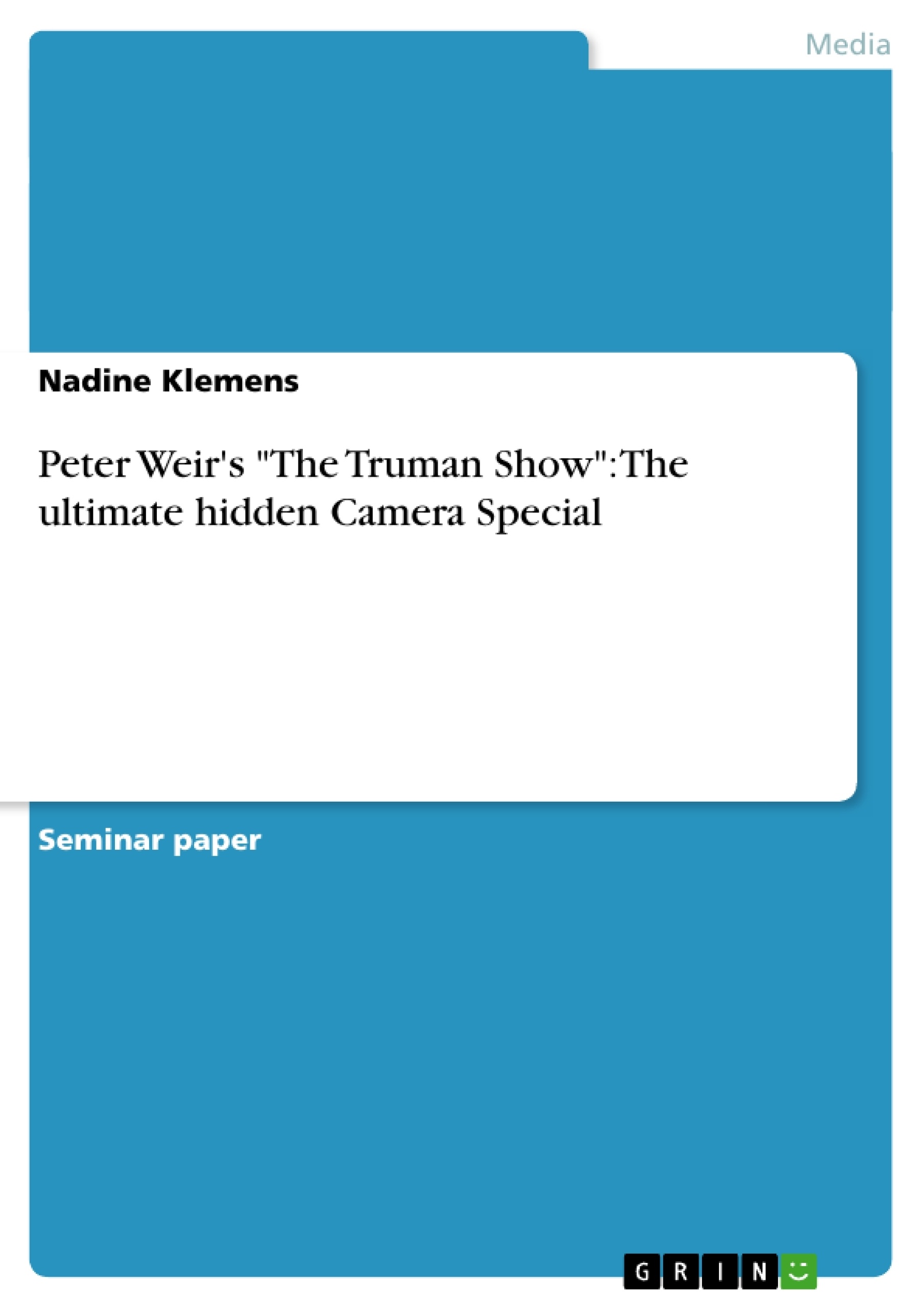Through a spy hole in a bathroom cabinet we see a man in pajamas talking to himself in the mirror. Or is he talking to us? After a while, we hear a voice of a woman, telling him that he will be late. With a sigh, the man turns around and leaves the bathroom. On a black screen, we read "Day 10, 909"- then we see the man through another spy hole, dressed in a business suit, leaving his house for work. He greets his neighbors with a wide grin, and the neighbors enthusiastically greet back. As he adds "Oh, and in case I don′t see ye: Good afternoon, good evening and good night!", they react as though they think this was extremely funny. When the dog of his next-door neighbor comes to greet him, the man freezes, on his face an expression of terror. He waits till the dog moves back and is about to get in his car when the camera suddenly pans and we see a theatrical light falling out of the sunny sky. Suspiciously, the man goes to examine what has crashed down on the street in front of his house. He does not know what to think of the light, which has a tag on it, designating it as "Sirius". In disbelief, he gazes into the sky- is this how stars look like?
The man is called Truman Burbank, and we are watching Peter Weir′s movie The Truman Show (1998). The movie is not a typical feature film as it mixes feature film elements and docu-soap elements. By confronting his audience with elements of its daily TV-programming, the docu-soap, Peter Weir establishes a satire of the media that leaves its viewers with the uneasy feeling that reality is not always what it appears to be.
This work gives a short summary of the movie, as well as it depicts its style and structure. Furthermore, Peter Weir′s thematic concerns are explained. The author describes docu-soaps and their appeal in order to explain which features of the docu-soap we can find in The Truman Show. The different levels of reality in the movie and the role of the audiences, that is, the tension between the perception of the viewers of the TV show inside the movie and the perception of the movie audience is another topic that is dealt with.
Table of Contents
- Introduction
- The movie
- The Truman Show with regard to Weir's complete works
- Docu-soaps and their appeal
- Docu-soap elements in The Truman Show
- Creating and perceiving reality
- The Truman Show as a satire of the media
- Conclusion
- Works cited
- Transcript
- Filmography of Peter Weir
- Stills
Objectives and Key Themes
This text aims to analyze Peter Weir's film The Truman Show (1998) by exploring its unique blend of feature film and docu-soap elements. It examines the film's portrayal of media manipulation, the construction of reality, and the tension between audience perception and the characters' experience. The text also considers Weir's thematic concerns and how The Truman Show fits within his wider filmography.
- The portrayal of docu-soaps and their appeal
- The film's critique of media manipulation and voyeurism
- The construction of reality and the blurring of boundaries between fiction and reality
- The role of the audience and their perception of the characters and events
- Peter Weir's recurring themes and stylistic choices
Chapter Summaries
The introduction of this text introduces the premise of The Truman Show, where the protagonist, Truman Burbank, is unknowingly the star of a 24-hour reality TV show. The text outlines the film's unique blend of feature film and docu-soap elements and establishes the overarching theme of media satire.
The chapter titled "The movie" provides a more detailed summary of the film's plot, focusing on Truman's discovery of his manipulated world and his attempts to escape. It also explores the film's visual style and structure, particularly the use of docu-soap and feature film elements.
The chapter "The Truman Show with regard to Weir's complete works" places the film in context with Peter Weir's other works, highlighting recurring themes and stylistic choices throughout his career. This chapter provides a brief overview of Weir's filmography, focusing on his most popular films.
The chapter "Docu-soaps and their appeal" delves into the genre of docu-soaps, exploring their popularity and the reasons for their appeal to audiences. This chapter analyzes the elements of docu-soaps that contribute to their success and provides a foundation for understanding how The Truman Show incorporates and satirizes these elements.
The chapter "Docu-soap elements in The Truman Show" examines the specific ways in which The Truman Show incorporates docu-soap elements, analyzing how these elements contribute to the film's critique of media manipulation and the construction of reality. This chapter explores the use of camera angles, editing techniques, and other stylistic choices to create a sense of voyeurism and to blur the lines between reality and fiction.
The chapter "Creating and perceiving reality" explores the film's examination of different levels of reality, focusing on the tension between the viewers of the TV show within the film and the audience watching the film. This chapter analyzes how the film challenges the audience's perceptions of what is real and how reality can be manipulated.
Keywords
The key themes and concepts explored in this text include docu-soaps, media manipulation, voyeurism, reality construction, audience perception, film style, Peter Weir's filmography, and satire.
- Quote paper
- Nadine Klemens (Author), 2002, Peter Weir's "The Truman Show": The ultimate hidden Camera Special, Munich, GRIN Verlag, https://www.grin.com/document/10452




